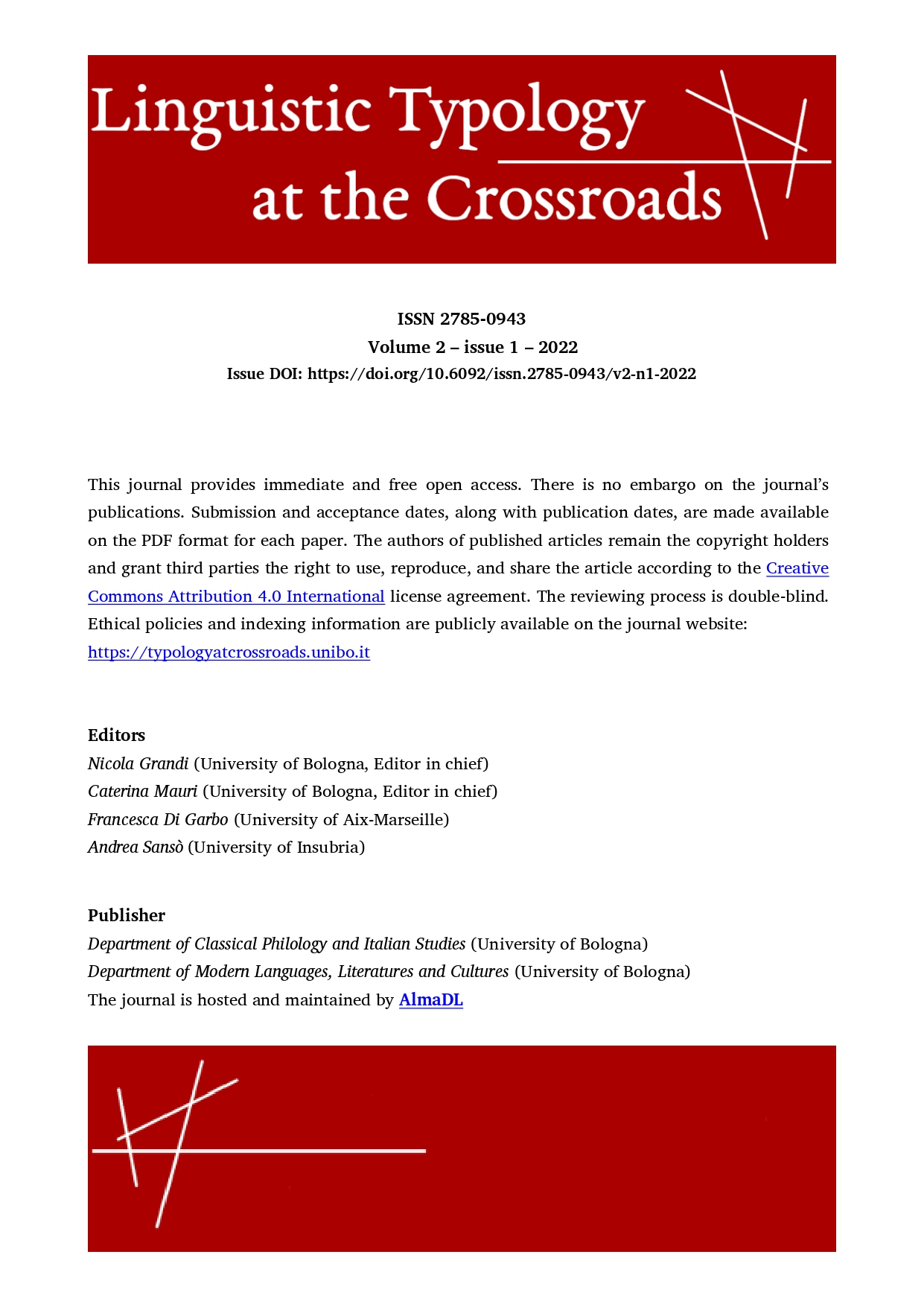Verb-argument lability and its correlations with other typological parameters. A quantitative corpus-based study
DOI:
https://doi.org/10.6092/issn.2785-0943/13861Keywords:
verb-argument lability, corpora, Universal Dependencies, word order, case marking, tight-fit and loose-fit languagesAbstract
We investigate the correlations between A- and P-lability for verbal arguments with other typological parameters using large, syntactically annotated corpora of online news in 28 languages. To estimate how much lability is observed in a language, we measure associations between Verbs or Verb + Noun combinations and the alternating constructions in which they occur. Our correlational analyses show that high P-lability scores correlate strongly with the following parameters: little or no case marking; weaker associations between lexemes and the grammatical roles A and P; rigid order of Subject and Object; and a high proportion of verb-medial clauses (SVO). Low P-lability correlates with the presence of case marking, stronger associations between nouns and grammatical roles, relatively flexible ordering of Subject and Object, and verb-final order. As for A-lability, it is not correlated with any other parameters. A possible reason is that A-lability is a result of more universal discourse processes, such as deprofiling of the object, and also exhibits numerous lexical and semantic idiosyncrasies. The fact that P-lability is strongly correlated with other parameters can be interpreted as evidence for a more general typology of languages, in which some tend to have highly informative morphosyntactic and lexical cues, whereas others rely predominantly on contextual environment, which is possibly due to fixed word order. We also find that P-lability is more strongly correlated with the other parameters than any of these parameters are with each other, which means that it can be a very useful typological variable.
Downloads
References
Aissen, Judith. 2003. Differential object marking: Iconicity vs. economy. Natural Language and Linguistic Theory 21. 435-483.
Creissels, Denis. 2014. P-lability and radical P-alignment. Linguistics 52(4). 911-944.
Dahl, Östen. 2000. Egophoricity in discourse and syntax. Functions of Language 7(1). 37-77.
Dixon, R.M.W. 1994. Ergativity. Cambridge: Cambridge University Press.
Fillmore, Charles J. 1986. Pragmatically Controlled Zero Anaphora. Proceedings of the Berkeley Linguistics Society 12. 95-107.
Gibson, Edward, Richard Futrell, Steven T. Piantadosi, Isabelle Dautriche, Kyle Mahowald, Leon Bergen, & Richard Levy. 2019. How efficiency shapes human language. Trends In Cognitive Sciences 23(5). 389-407.
Goldberg, Adele E. 2005. Argument realization: the role of constructions, lexical semantics and discourse factors. In Jan-Ola Östman & Miriam Fried (eds.), Construction Grammars: Cognitive grounding and theoretical extensions, 17-44. Amsterdam: John Benjamins.
Goldhahn, Dirk, Thomas Eckart & Uwe Quasthoff. 2012. Building large monolingual dictionaries at the Leipzig Corpora Collection: From 100 to 200 languages. In Nicoletta Calzolari, Khalid Choukri, Thierry Declerck et al. (eds.), Proceedings of the Eighth International Conference on Language Resources and Evaluation, 759-765. Istanbul: ELRA.
Greenberg, Joseph H. 1963. Some universals of grammar with particular reference to the order of meaningful elements. In Joseph H. Greenberg (ed.), Universals of human language, 73–113. Cambridge, Mass: MIT Press.
Haspelmath, Martin. 1993. More on the typology of inchoative/causative alternations. In Bernard Comrie & Maria Polinsky (eds.), Causatives and transitivity, 87–120. Amsterdam: John Benjamins.
Hawkins, John A. 1986. A Comparative Typology of English and German: Unifying the Contrasts. London: Croom Helm.
Hawkins, John A. 1995. Argument-predicate structure in grammar and performance: A comparison of English and German. In Irmengard Rauch & Gerald F. Carr (eds.), Insights in Germanic Linguistics, Vol. 1 Methodology in Transition, 127-44. Berlin: Mouton de Gruyter.
Hawkins, John A. 2012. The drift of English towards Invariable word order from a typological and Germanic perspective. In Terttu Nevalainen & Elizabeth C. Traugott (eds.), The Oxford Handbook of the History of English, 622-632. Oxford: Oxford University Press.
Hawkins, John A. 2014. Cross-linguistic Variation and Efficiency. Oxford: Oxford University Press.
Hawkins, John A. 2019. Word external properties in a typology of Modern English: A comparison with German. English Language and Linguistics 23(3). 701-723.
Letuchiy, Alexander. 2009. Towards a typology of labile verbs: Lability vs. derivation. In Patience Epps & Alexandre Arkhipov (eds.), New Challenges in Typology: Transcending the Borders and Refining the Distinctions, 247-268. Berlin / New York: De Gruyter Mouton.
Levin, Beth. 1993. English Verb Classes and Alternations: A Preliminary Investigation. Chicago: University of Chicago Press.
Levshina, Natalia. 2019. Token-based typology and word order entropy. Linguistic Typology 23(3). 533-572.
Levshina, Natalia. 2020. How tight is your language? A semantic typology based on Mutual Information. In Proceedings of the 19th International Workshop on Treebanks and Linguistic Theories, 70-78. Düsseldorf: ACL.
Levshina, Natalia. 2021. Cross-linguistic trade-offs and causal relationships between cues to grammatical subject and object, and the problem of efficiency-related explanations. Frontiers in Psychology 12. 648200.
Levshina, Natalia. 2022. Communicative Efficiency: Language Structure and Use. Cambridge: Cambridge University Press.
Müller-Gotama, Franz. 1994. Grammatical Relations: A Cross-Linguistic Perspective on Their Syntax and Semantics. Berlin: Mouton de Gruyter.
Nichols, Johanna. 1986. On form and content in typology. In Winfred P. Lehmann (ed.), Language Typology 1985: Papers from the Linguistic Typology Symposium, Moscow, 9-13 Dec. 1985, 141 - 162. Amsterdam: John Benjamins.
Nichols, Joanna, David A. Peterson, & Jonathon Barnes. 2004. Transitivizing and detransitivizing languages. Linguistic Typology 8. 149-211.
Plank, Frans. 1984. Verbs and objects in semantic agreement: Minor differences between English and German that might suggest a major one. Journal of Semantics 3(4). 305-360.
Shannon, Claude E. 1948. A Mathematical Theory of Communication. Bell System Technical Journal 27. 379-423, 623-656.
Wijffels, Jan, Milon Straka & Jana Straková. 2018. udpipe: Tokenization, parts of speech tagging, lemmatization and dependency parsing with the UDPipe NLP Toolkit. R package version 0.7.
Downloads
Additional Files
Published
How to Cite
Issue
Section
License
Copyright (c) 2022 Natalia Levshina, John A. Hawkins

This work is licensed under a Creative Commons Attribution 4.0 International License.





